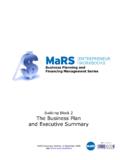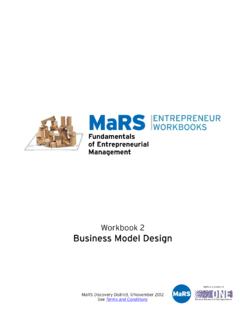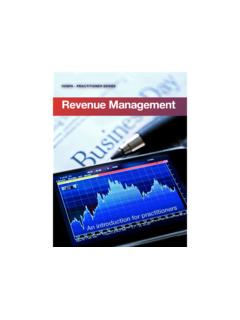Transcription of Workbook 2 Business Model Design - MaRS …
1 MaRS is a member ofMaRS Discovery District, November 2012 See Terms and ConditionsFundamentals of Entrepreneurial ManagementWorkbook 2 Business Model DesignMaRS is a member ofMaRS Fundamentals of Entrepreneurial Management Series2 MaRS DRRiscoDvieDRSr Introduction: Importance of Business modelsAll new businesses have to deal with the challenge of designing a sustainable Business Model . This is especially true for businesses with innovative products because they often disrupt parts of the industry value chain, which means that stakeholder relationships and revenue models must be crafted from scratch without the benefit of existing industry practices. While such a challenge might sound daunting, it also represents an opportunity to redefine an industry and reap the benefits of mastering a new way of doing 2: Business Model DesignThis Workbook is the second in a series of two Workbook guides that address the fundamentals of Business strategy for startups.
2 Workbook 1: Crafting Your Value Proposition Workbook 2: Business Model DesignAlthough the learning material is spread over two workbooks, you can consider them as two parts of a workbooks have been developed specifically for early-stage startups, and they address the key issues that entrepreneurs and their teams face. The following guidelines were key in developing this material: The information is based on solid practices and methodology The workbooks are not about reading they are about doing Speed and momentum are essential for startupsRelationship to value propositionsDeveloping your Business Model is best done once you have determined and validated your value proposition. The value proposition forms the core of your Business Model and concerns decisions of a higher order than most Business Model decisions. In other words, many Business Model decisions depend on value proposition decisions, not the other way around.
3 If you do not have a value proposition, then it can be difficult to determine if and how your Business will make money, which partners you will need, the nature of your key operations, and even your customer acquisition and relationship activities. The value proposition is also necessary for ensuring that all of these elements when put together are financially viable. We therefore recommend that you go through the Value Proposition Workbook guide before you begin working on your Business Model . MaRS Fundamentals of Entrepreneurial Management Series3 MaRS DRRiscoDvieDRSr How to use these workbooks1. Make it a team exerciseWe recommend that entrepreneurs work with their team and advisors when going through the steps of this Workbook . Doing so will ensure that together you develop a common understanding of where you are, the direction in which you are heading and the process of how to get there.
4 Fundamentally, the issues addressed in these workbooks should not be explored by a single person or department in isolation they should be a shared responsibility and Record and update your workWhen documenting the work in the Workbook activities, establish a format that suits your working style and is not too labour-intensive. Overall, we recommend that documentation be done in such a way that it does not slow the process. One such method would be to use a slide deck a PowerPoint template accompanies this Workbook for this purpose. The presentation format lends itself to documenting your plans and progress through shorter phrases and bullet points, and we recommend that format since much of what you write will be changed, clarified or expanded over time. 3. Use the icons for helpThe MaRS workbooks are created under the assumption that you have little or no experience as an entrepreneur and the topics covered in this Workbook .
5 To help provide context for some of the ideas in these workbooks, we have clarified them by defining key terms and offering real-world examples. In addition, we have provided links to articles provided by MaRS through the Entrepreneur s Toolkit. For this reason, you may find it easiest to use these workbooks on a computer with an Internet connection. Look for these icons:denotes a key industry term that will recur in these workbooksindicates an example drawn from a real-world Business in order to illustrate an important ideadenotes a link to a more in-depth online articleappears wherever you are asked to record something while completing the activitiesMaRS Fundamentals of Entrepreneurial Management Series4 MaRS DRRiscoDvieDRSr Before you startThe following flowchart will help you to understand the Business Model process, which is the basis for this Workbook . Individual steps will be explained in greater detail later in the Workbook .
6 However, it is useful to note that designing a Business Model is not always a linear process, but might involve several iterations before you settle on a final Business Fundamentals of Entrepreneurial Management Series5 MaRS DRRiscoDvieDRSr Workbook 2: Business Model Design1. Definition of Business modelThere are several ways to define a Business Model . Most people understand that a Business Model describes how you make money. However, a definition that focuses strictly on revenue generation is too limited for our purposes. Entrepreneurs who are in the process of designing their Business Model require an approach that allows them to understand if and how a value proposition can be successfully scaled up to a profitable Business . Scaling up refers to the process of progressing from creating and selling your first unit to a situation where you are creating and selling multiple units in a financially sustainable manner.
7 To make such an assessment, a Business Model must include operations, customer acquisition and retention, supply chain management, and the aforementioned cost and revenue aspects. With that in mind, we prefer the following definition: A Business Model describes the value an organization offers its customers and illustrates the capabilities and resources required to create, market and deliver this value and to generate profitable, sustainable revenue streams. (Osterwalder, A., Pigneur, Y., & Tucci, C. (May 2005). Clarifying Business Models: Origins, Present and Future of the Concept. Communications of the Association for Information Systems, Volume 15) This definition is particularly useful for entrepreneurs because it is based on a holistic perspective of the Business and emphasizes the sustainability aspect of a Business of this Workbook draw on the work of Alex Osterwalder and Yves Pigneur, who provided the definition of a Business Fundamentals of Entrepreneurial Management Series6 MaRS DRRiscoDvieDRSr Activity 1: Key Business Model questionsTo begin the process of designing the Business Model , please answer the following questions.
8 Answer as accurately as possible because you will need this information later in the How do you acquire customers? Briefly describe the steps involved, the amount of time required, the typical value of a deal and the stakeholders required (including the people on your side and the customers side) to sign a new After you have landed a new customer, how do you plan to relate to that customer and manage the relationship (if at all)?3. How do you charge your customers? What is your revenue Model ?4. How much do you charge your customers? Can you calculate your revenues for the next month, quarter and year?5. What assets are available to you or under your control?6. Who are your key partners?7. What key activities do you need to engage in to deliver your value proposition?8. What are your fixed costs?9. What are your variable costs? Can you calculate your total cost for the next month, quarter and year?
9 10. Does your revenue forecast demonstrate increased profitability toward the end of the forecast period MaRS Fundamentals of Entrepreneurial Management Series7 MaRS DRRiscoDvieDRSr 2. Preferred tool: The Business Model CanvasBased on our definition of a Business Model , it is clear that many factors must be factored in when designing a Business Model , which makes it a more complex task. Therefore, we recommend that entrepreneurs use the Business Model Canvas (a visual tool created by Alexander Osterwalder) to facilitate the Design process. The visual component of the tool simplifies the Design process by making it easier to understand how the various components of a Business affect each other. It also enables you to involve the rest of your team and advisors in the Business Model Canvas consists of nine interrelated building blocks, which are briefly described below in the order each block is typically you become more familiar with the contents of each building block and the flow between the related blocks, the Business Model Canvas will become easier to use.
10 The Building Model Canvas is versatile, as it can be used to Design a Business Model , which is the purpose of this Workbook ; it also functions as a diagnostic tool and aids in scenario planning. Customer segmentsThis building block involves describing the target customer. As mentioned above and in the first Workbook , the target customer is an explicit component of the value proposition. A startup often goes through an iterative phase of investigation and learning before settling on a target customer (the first Workbook describes these complexities).MaRS Fundamentals of Entrepreneurial Management Series8 MaRS DRRiscoDvieDRSr Value propositionLocated at the centre of the canvas, the value proposition links the left side ( , the upstream or supply side) of the document with the right side ( , the downstream or front office). The process of arriving at a value proposition has been covered in greater detail in the first Workbook , so we will refrain from going into greater detail.









